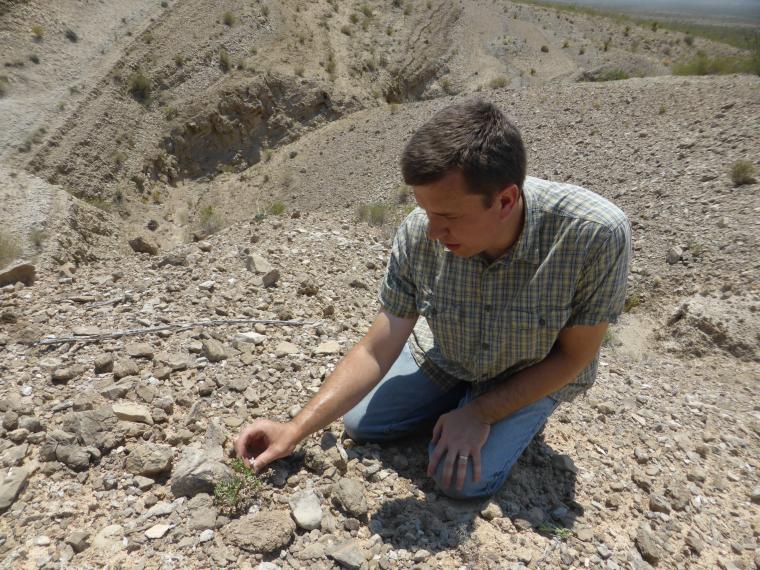(Desert) Plants Are Cool, Too
March 11, 2014
Amanda Nagy

Associate Professor of Biology Mike Moore points to a new plant species, Nerisyrenia hypercorax, which he discovered in the Chihuahuan Desert in August 2013.
Photo credit: Mike Moore
Associate Professor of Biology Mike Moore has traveled to some of the most isolated, uninhabited spots in the deserts of the United States and northern Mexico to find new species of plants on scattered outcrops of the mineral gypsum, which host an unusual group of plants that grow on no other type of soil. If you’re not an expert in plant systematics, like Moore, with an extensive knowledge of the different types of plants that grow on gypsum deposits, you’d never know the difference between these unassuming plants.
In the latest episode of a video series called “Plants are Cool Too” (PACT), Moore and a team of researchers show the lengths that scientists will go to explore plant diversity. Much of the diversity of desert plants is due to variances in soil, and gypsum deposits are basically like islands. “The plants adapt to these different soils, and they can totally respect the boundaries of the soils.”
For the makers of the video series and the scientists featured in the videos, what it all means is that plants are just as interesting as animals, and the people who study them are “weird in a good way.”
Ay, Chihuahua! New Species in the Desert!
The PACT series is directed and hosted by Chris Martine, an associate professor at Bucknell University. Filming took place over two days in August in the Chihuahuan Desert in New Mexico. Moore was on a four-week research trip with two collaborators from Mexico, Hilda Flores and Helga Ochoterena, professors of botany at the Institute of Biology at Universidad Nacional Autonoma de Mexico, and his postdoc, Norm Douglas. One of the main goals of the trip was to visit previously unexplored gypsum exposures throughout the Chihuahuan Desert.
Moore says the episode drives home two main points. First, it shows the lengths that people will travel to find new plant species. “We filmed at three different gypsum deposits, including in one of the most isolated places in southern New Mexico. Later on in the trip we visited some remote gypsum deposits in Mexico that no other botanists have collected at before. It’s very hard to get to get to some of these places.”
Second, the episode shows how much undiscovered biodiversity remains in deserts, even in places like the United States where botanists have collected extensively. “The diversity of plants in deserts is often due to soil. They get adapted to weird soils—you don’t see that in animals. We show how plants on different gypsum ‘islands’ have become different from each other. Because gypsum-adapted plants can’t grow off of gypsum, there’s no genetic exchange going on between these ‘islands’. So different populations become different species even though the ‘islands’ may be as little as 20 or 30 miles apart from each other.” Moore is interested in reconstructing the evolutionary history of these plants in order to understand how soils influence plant diversification.
When they filmed the episode of PACT, it didn’t take long for Moore and his collaborators to discover a new plant species. The first filming location was a remote gypsum exposure in southern New Mexico that has only been visited twice before by botanists, but never by Moore and his colleagues. After arriving at the site, he noticed an odd-looking plant in the mustard family. Moore recognized the plant as a member of the genus Nerisyrenia, “which is a group of similar-looking mustards that show a very high fidelity to gypsum habitats.” However, the Nerisyrenia plants at this site had leaves and fruits unlike any he had ever seen, and had been overlooked by previous botanists.
“We decided to name the new plant Nerisyrenia hypercorax. The name ‘hypercorax’ is Greek for ‘above the crow,’ which refers to the fact that the gypsum deposits where the new species is found occur on a hillside overlooking a valley called Crow Flats,” he explains. A scientific journal article that officially describes the new species will be published later this year.
Visiting the unexplored gypsum deposits of the Chihuahuan Desert has paid off for Moore and his colleagues. During his summer 2013 research trip, Moore and his collaborators discovered a total of six new species, three of which are in the United States. And over the last three years, they’ve found at least 11 new species on gypsum.
“Most of the time, people associate biodiversity with rainforests,” he says. “The desert is very diverse. We keep finding more and more things. The fact that these plants grow on little ‘islands’ of gypsum deposits helps promote speciation.”
Moore recently received a new round of funding from the National Science Foundation as part of a collaborative research grant with Stephen Smith of the University of Michigan and Sam Brockington of the University of Cambridge. A major goal of the project is to leverage recent advances in genome sequencing technologies and computational methods to evaluate the extent to which changes in life history and ecophysiology in plants are correlated with changes in the evolutionary rate of the genome. The project will support the mentorship and training of a postdoctoral researcher, graduate student, and numerous undergraduates on all aspects of the project, and will fund professional development workshops for high school teachers and plant biologists.
You may also like…
Friday Afternoon with Lab Crawl
This year’s Lab Crawl drew what may be the largest crowd in the event’s illustrious history, with some 500 students and dozens of faculty taking part. Missed out on the excitement? It looked something like this.
Lab Crawl: It’s Not Just for Scientists
Oct. 27 open house highlights research across the sciences—and just about everywhere else.
In the Path of Disaster
Monica Dix travels to a hub of natural calamity to probe its risks and resilience.


